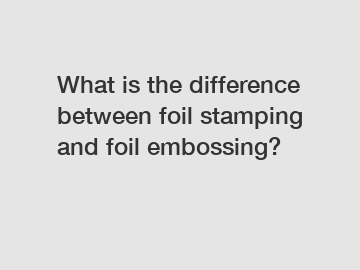Feb. 12, 2024
Machinery
What is the difference between foil stamping and foil embossing?
Foil stamping and foil embossing are techniques widely used in the printing and packaging industry to enhance the appearance of various products. Both processes involve the application of metallic foils to a surface, but they differ in terms of the desired effect and the way in which the foils are applied. In this article, we will explore the difference between foil stamping and foil embossing, helping you understand which technique is best suited to your needs.
Foil Stamping - Adding Elegance and Sophistication.

Foil stamping is a process that involves applying a metallic foil to a surface using heat and pressure. The foil is typically made of a thin layer of metal, such as gold, silver, or copper, which is affixed to a heated die. The die is then pressed onto the surface, causing the foil to adhere to the material.
The primary goal of foil stamping is to create a decorative and eye-catching design. The metallic foils used in the process can produce a luxurious and elegant effect, making it popular for high-end products such as book covers, business cards, certificates, and wedding invitations. Foil stamping can also be combined with other printing techniques, such as letterpress or embossing, to further enhance the visual impact.
Foil Embossing - Adding Texture and Dimension.
Foil embossing, on the other hand, involves creating a raised or three-dimensional design on a surface using a combination of heat, pressure, and metallic foils. In this process, a die is used to apply heat and pressure to a paper or cardstock, causing the material to compress and deform. At the same time, the metallic foils are applied, adhering to the raised areas of the surface.
The main purpose of foil embossing is to add texture and dimension to a design. By raising certain parts of the design, foil embossing creates a tactile and visually appealing effect that can make a significant impact on the overall appearance of the product. This technique is commonly used on packaging, such as wine labels, cosmetic boxes, and gift boxes, as well as on promotional materials like brochures and folders.
Choosing the Right Technique for Your Needs.
When deciding between foil stamping and foil embossing, it is essential to consider the desired effect you want to achieve. If your goal is to create an elegant and sophisticated design, foil stamping is likely the best choice. The metallic foils used in foil stamping can instantly elevate the visual appeal of any product, making it ideal for luxury brands or formal occasions.
On the other hand, if you want to add a tactile and dimensional aspect to your design, foil embossing would be the more suitable option. By creating raised areas on the surface, foil embossing immediately grabs attention and makes a statement. This technique can be particularly effective for packaging, as it invites the customer to interact with the product.
In conclusion, foil stamping and foil embossing are two distinct techniques that can greatly enhance the visual impact of printed materials. Foil stamping creates an elegant and luxurious effect, while foil embossing adds texture and dimension. Consider your specific needs and the desired outcome when choosing between these techniques. If you need further assistance or have any questions, please do not hesitate to contact us.
Contact Us.
Want more information on Automatic Gluing Machine Corrugated Box, Hot Foil Stamping Machine For Sale, Box Gluing Machine? Feel free to contact us.
If you are interested in sending in a Guest Blogger Submission,welcome to write for us!
All Comments ( 0 )